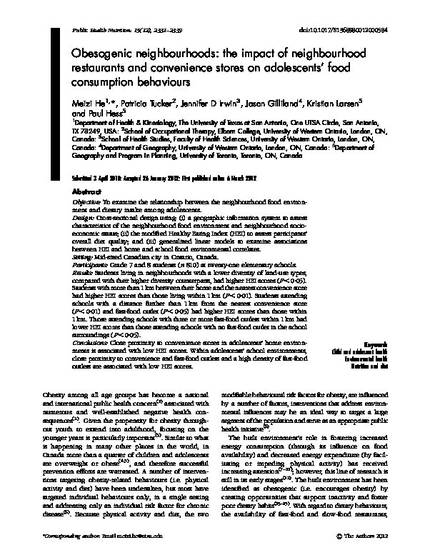
To examine the relationship between the neighbourhood food environment and dietary intake among adolescents. Cross-sectional design using: (i) a geographic information system to assess characteristics of the neighbourhood food environment and neighbourhood socio-economic status; (ii) the modified Healthy Eating Index (HEI) to assess participants' overall diet quality; and (iii) generalized linear models to examine associations between HEI and home and school food environmental correlates. Mid-sized Canadian city in Ontario, Canada. Participants Grade 7 and 8 students (n 810) at twenty-one elementary schools. Students living in neighbourhoods with a lower diversity of land-use types, compared with their higher diversity counterparts, had higher HEI scores (P < 0.05). Students with more than 1 km between their home and the nearest convenience store had higher HEI scores than those living within 1 km (P < 0.01). Students attending schools with a distance further than 1 km from the nearest convenience store (P < 0.01) and fast-food outlet (P < 0.05) had higher HEI scores than those within 1 km. Those attending schools with three or more fast-food outlets within 1 km had lower HEI scores than those attending schools with no fast-food outlet in the school surroundings (P < 0.05). Close proximity to convenience stores in adolescents' home environments is associated with low HEI scores. Within adolescents' school environments, close proximity to convenience and fast-food outlets and a high density of fast-food outlets are associated with low HEI scores.
He, M., Tucker, P., Irwin, J., Gilliland, J., Larsen, K., & Hess, P. (2012). Obesogenic neighbourhoods: The impact of neighbourhood restaurants and convenience stores on adolescents’ food consumption behaviours. Public Health Nutrition, 15(12), 2331-2339. doi:10.1017/S1368980012000584

Also available open access in Public Health Nutrition at: https://doi.org/10.1017/S1368980012000584